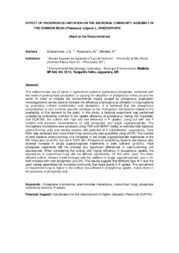Effect of phosphorus limitation on the microbial community assembly in the common bean (Phaseolus vulgaris L.) rhizosphere.
Effect of phosphorus limitation on the microbial community assembly in the common bean (Phaseolus vulgaris L.) rhizosphere.
Author(s): CHIARAMONTE, J. B.; ROSSMANN, M.; MENDES, R.
Summary: Abstract: The indiscriminate use of inputs in agricultural systems, particularly phosphate, combined with the need of growing food production, is causing the depletion of phosphorus mines around the world. In order to mitigate the environmental impact caused by phosphorus exploration microorganisms can be used to increase the efficiency of phosphorus utilization in crop systems by promoting nutrient solubilization and absorption. It is believed that low phosphorus concentration in soil, enriches specific members of the rhizosphere microbiome related to the availability of this element to the plant. In this study, a factorial experiment was performed considering contrasting cultivars in the uptake efficiency of phosphorus (being IAC-Imperador and DOR-364, the cultivar with high and low efficiency in P uptake); using soil with low P content and enriched concentrations of rock phosphate and single superphosphate. The rhizosphere microbiome was accessed using TSA and NBRIP media, to estimate total bacterial colony-forming units and identify isolates with potential of P solubilization, respectively. Total DNA was extracted and mycorrhizal fungi community was quantified using qPCR. The number of total bacteria colony-forming unit increased in the single superphosphate treatments of the IAC-Imperador (p<0.01), but not in DOR-364. Phosphorus solubilizing bacteria abundance also showed increase in single superphosphate treatments in both cultivars (p<0.01). Rock phosphate treatments did not showed any significant differences in colony-forming unit abundances. When considering the cultivar with higher efficiency in phosphorus uptake, the abundance of mycorrhizal fungi did not differed significantly. On the other hand, the lower efficient cultivar showed 5-fold increase with the addition of single superphosphate, and a 10-fold increase with rock phosphate (p<0.01). The results suggest that different type of P and the plant variety assembles the microbial community that helps plants in P uptake. The recruitment of mycorrhizal fungi is higher in the cultivar less efficient in phosphorus uptake, mainly when in the presence of phosphate rock.
Publication year: 2015
Types of publication: Abstract in annals or event proceedings
Unit: Embrapa Environment
Observation
Some of Embrapa's publications are published as ePub files. To read them, use or download one of the following free software options to your computer or mobile device. Android: Google Play Books; IOS: iBooks; Windows and Linux: Calibre.
Access other publications
Access the Agricultural Research Database (BDPA) to consult Embrapa's full library collection and records.
Visit Embrapa Bookstore to purchase books and other publications sold by Embrapa.

